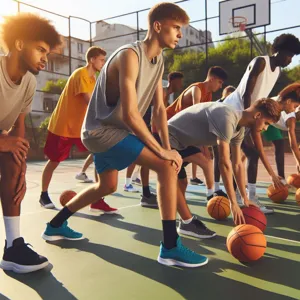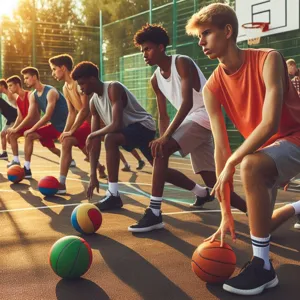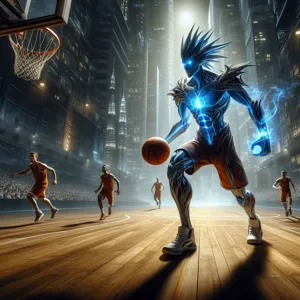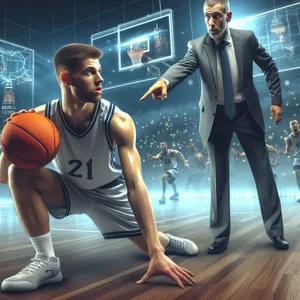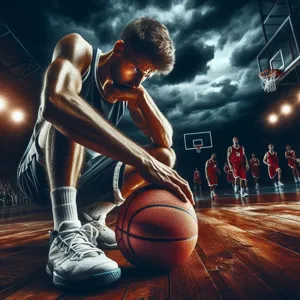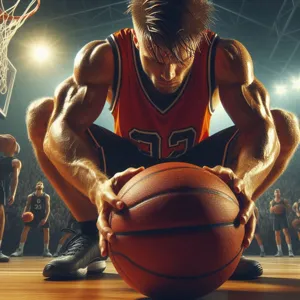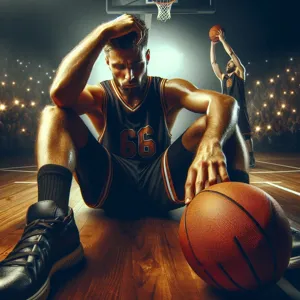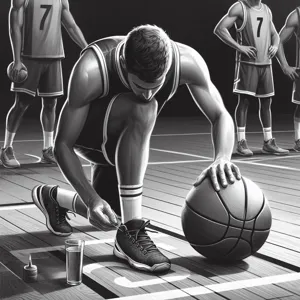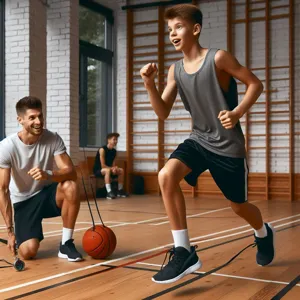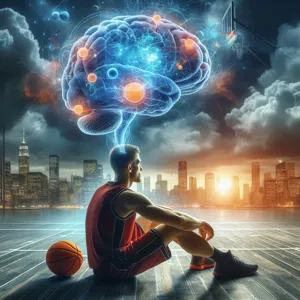Basketball is not just a game of skill; it’s an intense battle of nerves and strategy, especially when the stakes are high.
As the clock ticks down and the crowd roars, the pressure can become overwhelming, leading even the most talented players to falter. But what separates the greats from the good is their ability to master the pressure and perform under challenging circumstances. In this blog post, we will explore top strategies to help you handle anxiety, stay focused, and capitalize on high-pressure moments on the court. Whether you’re a seasoned player looking to refine your mental game or a newcomer eager to embrace the excitement of competitive play, our insights will empower you to transform pressure into your greatest ally. Join us as we dive into techniques that not only enhance your performance but also elevate your confidence, ensuring that you shine when it matters most.
1. Understanding Pressure: What It Means on the Court
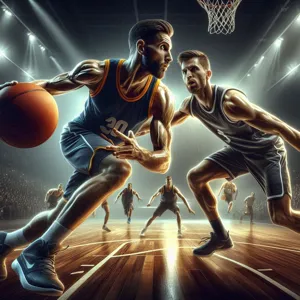
Pressure is an intrinsic part of basketball, and understanding what it truly means on the court can be the key to mastering your performance when the stakes are high. At its core, pressure in basketball refers to the heightened sense of urgency and expectation that players experience during critical moments of the game—be it a nail-biting playoff match, a tie game with seconds on the clock, or a last-minute shot that could make or break a win.
This pressure can manifest in various ways, including the intensity of the crowd, the weight of your teammates’ expectations, and even your own internal dialogue. You might feel your heart racing, your palms sweating, or your mind racing with doubts. Recognizing these physical and mental symptoms is the first step in learning how to cope with them effectively.
Understanding pressure also means acknowledging that it can be both a friend and a foe. While it can stifle performance, causing hesitation or errors, it can also fuel adrenaline, sharpening focus and enhancing skills. The key lies in how you harness that energy.
During high-pressure moments, players often find themselves at a crossroads: they can either succumb to the weight of the situation or channel the adrenaline into confident, decisive action. By developing a personal framework for understanding pressure—identifying triggers, managing emotional responses, and employing mental strategies—you can transform potentially crippling stress into a powerful tool for success.
practice is essential; simulation of high-pressure scenarios during training can prepare you for the real thing. Whether it’s shooting free throws with the game on the line or running plays in front of an audience, familiarizing yourself with these situations can build resilience. Ultimately, mastering the game under pressure isn’t just about skill; it’s about mental fortitude and the ability to maintain composure when it matters most.
2. The Psychology of Performance Under Pressure
Understanding the psychology of performance under pressure is crucial for any basketball player looking to elevate their game. When the stakes are high—be it in a nail-biting championship game or a crucial playoff match—how players respond mentally can make all the difference between victory and defeat.
Many athletes experience what is commonly referred to as “choking,” where the weight of the moment disrupts their natural abilities. This phenomenon often stems from heightened anxiety and self-doubt, leading to a disconnection between a player’s skills and their execution on the court. To combat this, it’s essential to develop a robust mental game. Techniques such as visualization can be incredibly effective; players should imagine themselves successfully executing plays, making crucial shots, and celebrating victories. This mental rehearsal not only boosts confidence but also conditions the brain to perform calmly when it matters most.
Another key element is maintaining a growth mindset. Instead of fearing mistakes, successful players view challenges as opportunities for improvement. Embracing the process and focusing on what can be learned from each experience helps to alleviate the pressure and allows players to perform more freely. Practicing mindfulness can also be beneficial—by staying present and concentrating on the current play rather than the game’s outcome, athletes can reduce anxiety and enhance their focus.
Moreover, establishing routines can provide a sense of normalcy in chaotic moments. Whether it’s a specific warm-up drill, a deep-breathing exercise, or a pre-game mantra, these rituals can serve as anchors, helping players to ground themselves amidst the frenzy of competition.
By understanding and harnessing the psychological aspects of performance under pressure, players can transform potential pitfalls into powerful advantages, ultimately mastering the mental game of basketball.
3. Pre-Game Mental Preparation Techniques

Mental preparation is just as crucial as physical training when it comes to excelling on the basketball court. Before the game, taking time to engage in pre-game mental preparation techniques can help athletes cultivate the focus, confidence, and composure needed to perform under pressure.
One effective method is visualization. Close your eyes and picture yourself executing plays flawlessly—dribbling past defenders, sinking shots, or making key assists. Imagine the sights, sounds, and feelings associated with these successful moments. This mental rehearsal not only helps to build confidence but also conditions your mind to react positively when game time arrives.
Another technique is positive self-talk. Replace any negative thoughts that creep in with affirmations that reinforce your abilities and readiness. Phrases like “I am prepared,” “I can handle any challenge,” or “I thrive under pressure” can shift your mindset, creating an optimistic atmosphere that propels you forward.
Deep breathing exercises are also invaluable. Taking a few moments to focus on your breath can reduce anxiety and center your thoughts. Inhale deeply through your nose, hold for a few seconds, and exhale slowly through your mouth. This simple practice calms the mind and prepares the body to face the intensity of the game.
Finally, consider establishing a pre-game routine that incorporates these techniques. Whether it’s listening to a favorite song, stretching, or meditating, having a consistent ritual can signal to your brain that it’s time to transition into game mode. By investing time in mental preparation, you equip yourself with the tools to navigate the pressures of the court, allowing your skills and instincts to take center stage.
4. Developing a Strong Mindset: The Power of Positive Thinking
In the high-stakes environment of a basketball game, where the pressure to perform is palpable and every second counts, cultivating a strong mindset is crucial for success. At the core of this mental resilience lies the power of positive thinking. It’s not just about wearing a smile or maintaining an upbeat demeanor; it’s about fostering a mental framework that empowers you to tackle challenges head-on and turn adversity into opportunity.
Positive thinking allows players to reframe their perceptions of pressure. Instead of viewing a tight game as a source of anxiety, embrace it as a chance to showcase your skills and determination. This shift in perspective can be transformational, enabling you to maintain your composure in critical moments. Visualization techniques can complement this mindset. Picture yourself sinking that game-winning shot or making a crucial defensive play, imagining the roar of the crowd and the sense of achievement that follows. This mental rehearsal not only boosts confidence but also prepares you to execute under pressure.
Moreover, surrounding yourself with positivity is essential. Engage with teammates who uplift and motivate one another. Celebrate small victories during practice, and acknowledge the progress made, regardless of how minor it may seem. This collective positivity reinforces a supportive environment where pressure feels less daunting and more manageable.
Finally, practice mindfulness and breathing techniques to center yourself during high-pressure situations. When the game intensifies, take a moment to focus on your breath, grounding yourself in the present moment. This simple act can help to clear your mind of distractions and anxiety, allowing you to channel your energy into your performance.
By developing a strong mindset rooted in positive thinking, you not only enhance your resilience on the court but also inspire those around you. Remember, the game is as much mental as it is physical—master the mental aspect, and you’ll find yourself thriving under pressure, ready to seize the moment when it matters most.
5. Visualization: Imagining Success Before the Game

Visualization is an incredibly powerful tool that can transform your mental game and elevate your performance on the basketball court. Before you even lace up your sneakers, take a moment to close your eyes and vividly imagine yourself executing every move with precision and confidence. Picture yourself dribbling down the court, feeling the ball’s texture against your fingertips, and effortlessly sinking shot after shot. The more detailed your mental imagery, the more effective it will be.
Visualize not just the ideal plays, but also the various scenarios you may face during the game: the pressure of a tight defense, the adrenaline of a buzzer-beater, or the energy of a roaring crowd. Envision yourself overcoming challenges, maintaining your composure, and making smart decisions under pressure. This mental rehearsal prepares your brain for the actual experience, making it easier to perform when it matters most.
Moreover, research has shown that athletes who practice visualization techniques often experience reduced anxiety and improved focus. By establishing a mental routine that includes imagery, you can train your mind to stay calm and collected, turning pressure into an opportunity for greatness. So, before you step onto the court, invest a few moments in this powerful practice. Visualizing your success not only boosts your confidence but also sets the stage for a game well played. In the heat of competition, remember that the mind is just as crucial as the body—master it, and you’ll be well on your way to becoming a clutch player.
6. Breathing Techniques to Stay Calm and Focused
In the high-paced world of basketball, where the clock ticks down and stakes rise with every dribble, maintaining composure can be the difference between victory and defeat. One of the most effective yet often overlooked strategies to manage this pressure is the use of breathing techniques. By harnessing the power of your breath, you can ground yourself in the moment, enhancing both your focus and performance.
Start by practicing deep diaphragmatic breathing, which involves inhaling deeply through your nose, allowing your diaphragm to expand fully. This technique not only increases oxygen flow to your muscles but also triggers a relaxation response in your body. As you inhale, count to four, then hold for a moment before exhaling slowly through your mouth for a count of six. This method not only calms your nerves but also helps clear your mind, allowing you to visualize plays and anticipate your opponent’s moves.
In the heat of the game, remember to take a few moments during free throws or timeouts to center yourself with this breathing practice. Inhale deeply, envisioning positive outcomes, and exhale any tension or distractions. This simple act can help reset your mental state, enabling you to approach each play with clarity and confidence.
Additionally, incorporating breathing exercises into your regular training routine can strengthen your ability to remain calm under pressure. Consider dedicating a few minutes each day to focused breathing, perhaps following your warm-up or cooldown. As you become more attuned to your breath, you’ll find that it becomes a powerful tool for maintaining composure when it matters most—whether you’re draining a three-pointer at the buzzer or defending against a last-minute drive. With consistent practice, these breathing techniques can transform your mental game, allowing you to thrive even in the most intense basketball situations.
7. In-Game Strategies for Managing Stress

When the clock is ticking down and the stakes are high, managing stress on the basketball court becomes essential for both individual performance and team dynamics. Here are some effective in-game strategies to help you maintain composure, enhance focus, and ultimately elevate your game under pressure.
**1. Controlled Breathing Techniques:** One of the simplest yet most powerful methods to manage stress is through controlled breathing. When you feel the adrenaline surge, take a moment to inhale deeply through your nose, hold for a few seconds, and exhale slowly through your mouth. This technique not only calms your mind but also helps regulate your heart rate, allowing you to approach each play with a clearer perspective.
**2. Positive Self-Talk:** The power of positive self-talk cannot be underestimated. Replace negative thoughts with affirmations that reinforce your skills and confidence. Phrases like “I’ve practiced for this” or “I can make this shot” can help shift your mindset and reduce anxiety, allowing you to focus on the present moment rather than the potential outcomes.
**3. Focus on the Fundamentals:** In high-pressure situations, it’s easy to get caught up in the intensity of the moment. Remind yourself to return to the basics—dribbling, passing, and shooting techniques. By concentrating on fundamental skills, you can channel your energy into executing plays rather than overthinking the consequences of each move.
**4. Utilize Team Support:** Basketball is a team sport, and leaning on your teammates can significantly alleviate stress. Establish a system of verbal and non-verbal cues during the game to encourage one another. Simple gestures, like a thumbs-up or a quick shout of motivation, can create a bond that fosters resilience and boosts morale, reminding everyone that you’re in this together.
**5. Visualize Success:** Before the game, and even during timeouts, take a moment to visualize successful plays. Picture yourself making that crucial shot or executing a perfect pass. This mental rehearsal not only enhances your confidence but also helps to ground your emotions, making it easier to handle the pressure when the moment arrives.
**6. Maintain a Routine:** Routines can provide a sense of stability in chaotic situations. Whether it’s a specific warm-up drill, a pre-game snack, or a particular playlist you listen to, having a consistent routine can help you feel more grounded and focused during the game. Familiarity breeds comfort, allowing you to channel your energy into performance rather than stress.
By integrating these in-game strategies into your routine, you’ll be better equipped to handle the pressures of the basketball court. Remember, stress is a natural part of the game; it’s how you respond to it that will ultimately define your success. Embrace the challenge, trust your training, and let your passion for the game shine through, no matter the situation.
8. The Importance of Routine: Creating Consistency
In the fast-paced, high-stakes environment of the basketball court, pressure can feel overwhelming. However, one of the most effective ways to manage that pressure is by establishing a solid routine. Routines provide a sense of consistency and familiarity, allowing players to focus their minds and channel their energy into performance rather than distraction.
Imagine stepping onto the court knowing exactly what to expect. A pre-game ritual that includes everything from your warm-up exercises to your shooting drills can set the tone for the entire match. This consistency not only boosts your confidence but also calms your nerves. As you repeat these actions, your body begins to recognize and respond to the rhythm, creating a state of flow that can enhance your performance when it matters most.
Consider also the mental aspect of your routine. Visualization techniques, where you mentally rehearse successful plays or shots, can be woven into your pre-game rituals. This prepares your mind for the challenges ahead, ensuring that when you encounter pressure situations—like the final seconds of a tight game—you can rely on that mental muscle memory.
Moreover, a consistent routine helps in maintaining focus during practice sessions. It allows players to hone specific skills repetitively, making them second nature when the pressure is on. Whether it’s perfecting your three-point shot or mastering defensive strategies, a structured approach to practice can lead to remarkable improvements over time.
In essence, creating a routine isn’t just about going through the motions; it’s about building a foundation of confidence and performance that can withstand the pressures of the game. When you embrace the power of routine, you’re not just preparing for a single game; you’re equipping yourself for a lifetime of success on the court.
9. Building Confidence Through Practice and Repetition
Building confidence through practice and repetition is the cornerstone of success on the basketball court. Picture this: the arena is packed, the crowd is roaring, and the tension is palpable as the clock ticks down. It’s in these high-pressure moments that your confidence will either shine or falter, and that confidence is forged in the countless hours of practice leading up to the game.
Repetition is key. Whether it’s perfecting your shooting form, honing your dribbling skills, or mastering defensive maneuvers, consistent practice allows you to develop muscle memory. When you’ve run through the same drills time and time again, your body instinctively knows what to do, allowing your mind to focus on the game rather than second-guessing your movements. This familiarity breeds a deep-seated assurance that you can perform under pressure.
Moreover, practice isn’t just about physical skills; it’s also about mental fortitude. By simulating high-pressure scenarios during training—such as time-limited drills or scrimmages with heightened stakes—you can learn to manage anxiety and maintain composure when it matters most. Visualize yourself succeeding in these situations, and with each successful execution of a play during practice, you’re reinforcing a positive mindset.
Additionally, embracing a growth mindset during practice can help you build resilience. Understand that mistakes are part of the learning process. Instead of dwelling on errors, focus on what you can improve, and treat each practice session as an opportunity to grow. This approach not only enhances your skills but also instills a sense of confidence that you can tackle challenges head-on.
In summary, confidence on the basketball court is not a gift bestowed only on the naturally talented; it is a product of diligent practice and relentless repetition. By committing to your training, embracing challenges, and learning from your experiences, you will cultivate a strong sense of self-assurance that can withstand the pressures of the game. So lace up your sneakers, hit the court, and watch your confidence soar as you master the art of handling pressure.
10. Communication: Leaning on Teammates for Support
On the basketball court, pressure can mount quickly, transforming a game into a high-stakes situation where every moment counts. One of the most effective strategies to navigate this intensity is through open and effective communication with your teammates. In these critical moments, leaning on your teammates for support not only alleviates individual pressure but also fosters a sense of unity that can elevate the entire team’s performance.
Effective communication starts long before the game, during practice sessions when players build trust and develop an intuitive understanding of each other’s playing styles. This connection becomes vital during heated moments when decisions need to be made in a split second. Whether it’s calling for a screen, signaling for help on defense, or directing traffic during a fast break, clear communication ensures that everyone is on the same page, minimizing confusion and maximizing efficiency.
Moreover, using positive and encouraging language can boost morale and reinforce confidence. A simple shout of encouragement or a strategic reminder can inspire teammates to push through their doubts. When a player is feeling the pressure—perhaps during a crucial free-throw situation—hearing a teammate’s voice offering reassurance can make all the difference.
Additionally, leaning on each other doesn’t just mean talking; it also involves non-verbal cues. Eye contact, hand signals, and body language can communicate crucial information without disrupting the flow of the game. Recognizing when a teammate is struggling and providing support, whether with a pat on the back or by stepping up your own performance, can create an environment where everyone feels empowered to contribute.
In essence, communication is not just about relaying information; it’s about building a resilient network of support on the court. By fostering strong connections and maintaining open lines of dialogue, players can effectively manage the pressures of the game, transforming challenges into opportunities for collective success. So, the next time you find yourself in a high-pressure moment, remember that you’re not alone—lean on your teammates, and let the power of communication guide you through.
11. Learning from Failure: Turning Pressure into Growth
In the high-stakes world of basketball, pressure is an inevitable companion. Whether it’s a nail-biting game on the line or the weight of expectations bearing down during practice, how you respond to failure can define your growth as a player. Embracing failure is not just about accepting mistakes; it’s about transforming those moments into powerful learning experiences that fuel your development on the court.
When you miss a crucial shot or commit a turnover during a crucial play, it’s easy to spiral into frustration. However, the key to mastering pressure lies in your ability to analyze these setbacks objectively. Take the time to dissect what went wrong. Was it a lapse in focus? Did you rush your shot? Or perhaps your footwork needed adjustment? By pinpointing the root cause of your mistakes, you can create a targeted plan for improvement.
Moreover, view each failure as a stepping stone toward success. Champions are not defined by their victories alone but by their resilience in the face of adversity. Use these moments as motivation to refine your skills. Consider keeping a journal where you document your games, noting both successes and challenges. Reflecting on these entries can provide valuable insights over time and help you track your progress.
Additionally, sharing your experiences with teammates can foster a culture of growth within your team. Discussing failures openly encourages camaraderie and understanding, reminding everyone that they are not alone in their struggles. Learning together can lead to collective improvement, making your team stronger under pressure.
Lastly, remember that every great athlete has faced defeat. It’s the ability to learn from those experiences and convert them into growth that sets apart the good from the great. Embrace the pressure, learn from your failures, and watch as you evolve into a more resilient and skilled basketball player. In the end, it’s not just about winning games; it’s about mastering the journey of growth that comes with every challenge faced on the court.
12. Nutrition and Hydration: Fueling the Body for Peak Performance
When it comes to mastering the game of basketball, the importance of nutrition and hydration cannot be overstated. The court is a battlefield, and just like any athlete, a basketball player needs the right fuel to endure the intense physical demands of the game. proper nutrition not only enhances performance but also plays a crucial role in mental clarity and stamina.
Start with a balanced diet rich in carbohydrates, proteins, and healthy fats. Carbohydrates serve as the primary energy source, providing the quick bursts of fuel needed for sprinting up and down the court, while proteins help repair and build muscle tissues. Incorporate plenty of fruits and vegetables to ensure that your body receives essential vitamins and minerals that support overall health and recovery. Foods like bananas, quinoa, and lean meats can be particularly beneficial, providing lasting energy and aiding in muscle repair.
Hydration, on the other hand, is equally vital. During a game, players can lose significant amounts of water through sweat, leading to dehydration, which can severely impair performance. It’s essential to start hydrating well before game day; aim to drink ample water throughout the day and consider sports drinks that can help replenish electrolytes lost during intense play.
Pay attention to pre-game meals—eating a carbohydrate-rich meal 2-3 hours before tip-off can provide sustained energy levels. Post-game, focus on recovery with a meal or snack that includes both protein and carbohydrates to help rebuild muscle and replenish energy stores.
By prioritizing nutrition and hydration, you will not only enhance your physical capabilities but also sharpen your mental focus, allowing you to handle pressure with poise and confidence on the court. Remember, your body is your most valuable asset in the game of basketball, so treat it with the care it deserves.
13. Real-Life Examples: Athletes Who Excelled Under Pressure
When it comes to performing under pressure, few athletes have showcased this skill as vividly as Michael Jordan. Known for his uncanny ability to deliver in clutch moments, Jordan’s legacy is punctuated by his iconic game-winning shot in the 1998 NBA Finals against the Utah Jazz. With just seconds left on the clock, he faced immense pressure, yet he remained composed, sinking the shot that secured his sixth championship. This moment is a testament to his mental fortitude and relentless practice, serving as an inspiration for players who aspire to thrive in high-stakes situations.
Another remarkable example is Kobe Bryant, whose “Mamba Mentality” became synonymous with resilience and focus. Throughout his illustrious career, Bryant embraced the spotlight, often taking the final shot in crucial moments. His legendary performance against the Toronto Raptors in 2006, where he scored an astonishing 81 points, showcased his ability to harness pressure as a driving force. Bryant’s commitment to preparation and his unwavering self-belief allowed him to rise above the noise and deliver unforgettable performances.
On the women’s side, Maya Moore’s exceptional poise in high-pressure scenarios has set her apart. During the 2017 WNBA Finals, with her team trailing, Moore delivered a breathtaking performance that helped the Minnesota Lynx clinch the championship. Her ability to stay focused and make critical plays despite the mounting pressure exemplifies the qualities that all athletes should strive for.
These examples illustrate that pressure is not merely an obstacle to overcome but an opportunity for greatness. By studying the strategies and mindsets of these elite athletes, players at all levels can learn to embrace pressure, transform it into motivation, and ultimately excel on the court. Whether through rigorous practice, mental conditioning, or developing a resilient mindset, aspiring basketball players can draw strength from these real-life examples to master their own game under pressure.
14. Post-Game Reflection: Analyzing Performance and Improvement
Post-game reflection is a critical yet often overlooked aspect of mastering your performance on the basketball court. After the final buzzer sounds, it’s easy to get swept up in the emotions of victory or defeat, but taking the time to analyze the game can be a game-changer for your skills and mindset.
Start by reviewing key moments that defined the game—whether it was a clutch three-pointer, a critical turnover, or an outstanding defensive play. Consider keeping a journal specifically for your basketball experiences where you can jot down your thoughts, feelings, and observations. This reflection process helps you identify patterns in your play, whether they be strengths to build upon or weaknesses to address.
Utilizing video analysis can significantly enhance your understanding of your performance. Watching game footage allows you to see firsthand what worked and what didn’t. Pay attention to your positioning, decision-making, and teamwork. Did you take the right shots? Were you in sync with your teammates? This visual feedback is invaluable for recognizing areas for improvement.
Additionally, don’t hesitate to seek feedback from coaches or teammates. They can provide insights that you may have missed and help you gain a different perspective on your performance. Constructive criticism is essential for growth, so embrace it as a tool for development rather than a setback.
Finally, set specific, measurable goals for your next game based on your reflections. Whether it’s improving your defensive stance, increasing your free throw percentage, or enhancing your communication on the court, having clear objectives will keep you motivated and focused on continuous improvement. Remember, every game is a learning opportunity, and post-game reflection is your chance to turn those experiences into tangible progress on the court.
15. Conclusion: Embracing Pressure as a Path to Mastery
In the high-stakes environment of the basketball court, pressure is not just an obstacle; it’s a formidable teacher. As we conclude our exploration of strategies for handling pressure, it’s essential to recognize that embracing this intensity can lead you to become not just a better player, but a more resilient athlete. Every clutch moment, every nail-biting game, and every challenging opponent serves as an opportunity to hone your skills and fortify your mindset.
Mastering the game under pressure begins with a shift in perspective. Instead of viewing pressure as a threat, see it as a catalyst for growth. This mindset allows you to transform anxiety into focus, turning what could be a paralyzing experience into a powerful motivator. By practicing visualization techniques, mindfulness, and the art of staying present, you can cultivate an environment where pressure becomes an ally rather than an enemy.
Moreover, consistency is key. The more you expose yourself to high-pressure situations in practice—be it through scrimmages, pressure drills, or competitive simulations—the more familiar and manageable these scenarios will become. This repetitive exposure builds confidence and equips you with a toolkit of strategies to draw upon when the stakes are highest.
Ultimately, the journey to mastering pressure is a personal one, unique to each athlete. Embrace the challenges, learn from every experience, and remember that even the greatest players faced adversity. By welcoming pressure into your game, you not only enhance your performance on the court but also develop invaluable life skills that extend far beyond basketball. So, the next time you feel the weight of the moment pressing down on you, take a deep breath, remember your training, and rise to the occasion. In doing so, you’ll find that pressure isn’t just a part of the game; it’s a vital stepping stone on your path to mastery.
As we wrap up our exploration of strategies to master pressure on the basketball court, remember that handling high-stakes situations is as much about mental fortitude as it is about skill. By incorporating techniques such as visualization, deep breathing, and effective communication with your teammates, you can transform pressure into an opportunity for success. Embrace the challenges that come with the game, and use them as a springboard for personal growth and improvement. Whether you’re a seasoned player or just starting out, these strategies can empower you to perform at your best when it matters most. Now, lace up those sneakers, hit the court, and let your newfound confidence shine through in every game you play!







